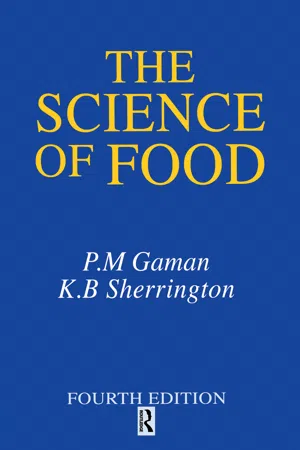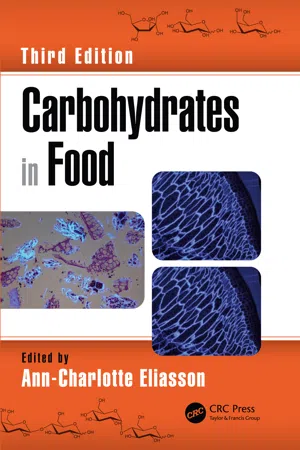Carbohydrates
Carbohydrates are organic compounds made up of carbon, hydrogen, and oxygen. They serve as a primary source of energy for living organisms and are essential for various cellular processes. Carbohydrates can be found in foods such as fruits, vegetables, grains, and dairy products, and they play a crucial role in the structure of cells and tissues.
7 Key excerpts on "Carbohydrates"
- eBook - ePub
- Antonio Blanco, Gustavo Blanco(Authors)
- 2017(Publication Date)
- Academic Press(Publisher)
...Carbohydrates are also widely distributed in animals, where they form molecules of diverse structural and functional relevance. Plants synthesize Carbohydrates from CO 2 and H 2 O by capturing the energy from light in the process of photosynthesis. These Carbohydrates are ingested by animals, and largely used as fuel. In humans, Carbohydrates are the main source of energy. In a balanced diet, they provide 50%–60% of the total calories needed by an individual. Carbohydrates are composed of carbon, hydrogen, and oxygen and are defined as polyhydroxy-aldehydes or polyhydroxy-ketones. They have an aldehyde or ketone and various alcoholic functions. Substances that render these polyhydroxy-aldehydes or polyhydroxy-ketones when subjected to hydrolysis are also considered Carbohydrates. Classification. Depending on their complexity, Carbohydrates are classified into monosaccharides, oligosaccharides, or polysaccharides. 1. Monosaccharides, also known as simple sugars, they consist of only one polyhydroxy-aldehyde or polyhydroxy-ketone. They are obtained as water soluble white crystals and many of them are sweet. Glucose is the most important member of this group. 2. Oligosaccharides are polymers formed of 2–10 monosaccharides that can be separated by hydrolysis. According to the number of molecules that constitute them, they are designated disaccharides, trisaccharides, tetrasaccharides, etc. Representatives of greater interest within this group are the disaccharides. They are water soluble, can be obtained in crystalline state, and generally have a sweet taste. 3. Polysaccharides are large molecules, formed by the assembly of monosaccharides, arranged in linear or branched chains. In general, they are water insoluble, tasteless, and amorphous. Monosaccharides Simple sugars can be defined as polyhydroxy-aldehydes (polyols-aldehydes) or polyhydroxy-ketones (polyols-ketones)...
- eBook - ePub
- K. B. Sherrington, P. M. Gaman(Authors)
- 2010(Publication Date)
- Routledge(Publisher)
...5 Carbohydrates Carbohydrates are a group of nutrients important in the diet as a source of energy. They contain the elements carbon, hydrogen and oxygen and are produced in plants by the process of photosynthesis, which may be represented by the following equation: Chlorophyll is a green pigment which absorbs energy from sunlight and enables plants to build up Carbohydrates from carbon dioxide and water. There are various different Carbohydrates but they may be divided into three main groups according to the size of their molecules: Sugars 1 Monosaccharides The monosaccharide sugars commonly found in food contain six carbon atoms and have the general formula C 6 H 12 O 6. The three most important members of this group are: (A) Glucose (Dextrose) The structure of a molecule of glucose is shown in Figure 5.1. In the conventional representation the carbon atoms in the ring are omitted. Figure 5.1 Structure of glucose. Glucose is found in varying amounts in fruits and vegetables. Large amounts are found in fruits such as grapes and smaller quantities in vegetables such as young peas and carrots. It is also found in the blood of animals. Glucose syrup or commercial glucose is not pure glucose but a mixture of glucose, other Carbohydrates and water (see page 65). (B) Fructose (Laevulose) This is chemically similar to glucose except that the arrangement of the atoms within the molecule is slightly different. Fructose is found, together with glucose, in many fruits and in honey. (C) Galactose This is also chemically similar to glucose. It does not exist as such in foods but is produced when lactose, a disaccharide, is broken down during digestion. 2 Disaccharides These sugars have the general formula C 12 H 22 C 11. They are formed when two monosaccharide molecules combine with the elimination of a water molecule. This is an example of a condensation reaction, i.e...
- eBook - ePub
- Jose Perez-Castineira(Author)
- 2020(Publication Date)
- De Gruyter(Publisher)
...3 Carbohydrates 3.1 Definition, terminology, and classification Carbohydrates are a family of biomolecules composed, in principle, by carbon (C), hydrogen (H), and oxygen (O) atoms whose basic general formula is C n (H 2 O) m. The fact that many Carbohydrates have two atoms of hydrogen per atom of oxygen in their molecules is responsible for the somewhat misleading name that these molecules have, as “hydrate” means “containing water.” Carbohydrates have no water in their chemical composition, as we shall see in this Chapter, although they are usually hydrated to different degrees both in vivo and in vitro. Carbohydrates are usually constituted by an indeterminate number of basic units linked forming polymers. The connections among these units may occur by means of different linkage types, thereby allowing many structural variations [ 1 ]. There are several important terms related to Carbohydrates: Monosaccharides : They are the basic non-hydrolyzable units of Carbohydrates. Monosaccharides can be chemically altered yielding derivatives that may also form polymers. These alterations may involve the addition of elements such as nitrogen (N), sulfur (S), or phosphorus (P). Oligosaccharides. Molecules composed of 2 to 12 (20 for some authors) linked units (residues) of monosaccharides by a specific type of chemical bond known as glycosidic bond. Oligosaccharides are denoted according to the number of monosaccharide residues they have: disaccharides (2 units), trisaccharides (3), tetrasaccharides (4), and so on. Sugar: Many monosaccharides and disaccharides are sweet, hence their trivial name sugars, although table sugar is only composed of sucrose, a disaccharide. Carbohydrates are also known as glycids (from the Greek glykys, glykeros : sweet) or saccharides (from the latin saccharum : sugar). Polysaccharides : Polymers composed of more than 12 (or 20) residues of monosaccharides...
- eBook - ePub
- Raymond S. Ochs(Author)
- 2021(Publication Date)
- CRC Press(Publisher)
...4 Carbohydrates Carbohydrates are most commonly encountered as the sweetener sucrose and as starch, the nutrient of bread and pasta. The Carbohydrates are literally hydrates of carbon, having the empirical formula (CH 2 O) n. Because they possess both hydroxyl and carbonyl groups, they are a step up in complexity from lipids. Unlike lipids, Carbohydrates are generally very soluble in water. The Latin word for sugar is saccharide ; this is commonly used in the term polysaccharides. Sugars are nutrients for both animals and plants. Animals use sugars for rapid (i.e., minute-to-minute) energy production and lipids for long-term storage. Plants use sugars for energy exclusively, except at the seed stage. Sugars have greater weight than lipids, making them less suitable for long-term energy storage for organisms with mobile lifestyles (i.e., animals and seeds). The reason for the greater mass of sugars is two-fold. Sugars contain more oxygen atoms and are thus denser than lipids. Sugars also associate with water (through hydrogen bonding), further increasing their weight. Aside from providing energy, sugars have a wide variety of roles once they are chemically modified, such as cell–cell recognition and signaling. The specificity of blood group types derives from sugars attached to membrane lipids of red blood cells. Proteins secreted from cells are usually covalently linked to sugars. Thus, sugars are integral to biological function. We begin our study of sugars with the simplest ones: the monosaccharides. 4.1 Monosaccharides Monosaccharides have a single carbonyl group, which occurs at the first or second carbon atom. All remaining carbons have an attached hydroxyl group. There are two classes of monosaccharides: aldoses and ketoses. Aldoses (aldehydes) have the carbonyl at carbon one, whereas ketoses (ketones) have the carbonyl at carbon two. The “-ose” suffix (as in aldose and ketose) usually indicates that a compound is a sugar...
- eBook - ePub
- Ann-Charlotte Eliasson, Ann-Charlotte Eliasson(Authors)
- 2017(Publication Date)
- CRC Press(Publisher)
...Preface We meet them, the Carbohydrates, in fruits and berries, beans, bread, pasta, confectionaries, soft drinks, and so on. As Carbohydrates in food can include anything from the simple monosaccharide glucose to the very complex polysaccharides found in cell walls, it is not surprising that we find them in so many different foods. The Carbohydrates are there either as a component of the raw material or as an added ingredient. Due to the huge differences in their chemical composition, the same properties cannot be attributed to all the Carbohydrates, and it is thus necessary to have a good knowledge about the chemical structure of the carbohydrate you are dealing with. Moreover, several different Carbohydrates are usually present in the same product, perhaps resulting in synergistic or antagonistic behavior. To obtain the required product properties, it is seldom possible to choose one simple carbohydrate or even a well-characterized carbohydrate. This book deals with all these Carbohydrates: monosaccharides and disaccharides, cell-wall polysaccharides, polysaccharides described as gums and hydrocolloids, and starch. Both analytical and functional aspects are discussed. In the second edition of this book, it was pointed out that Carbohydrates in the diet had been in focus from a nutritional point of view much more than ever before. This is even more so today, and diets low in Carbohydrates are advocated by some as healthier. However, what is often forgotten in the discussion is the complexity of Carbohydrates. High sucrose consumption might not be good for your health, but this doesn’t mean that you also should avoid cell-wall polysaccharides. Awareness of health aspects of our diet is growing, and a huge challenge today is to combine health benefits with sensory properties that appeal to the consumer. Food products should also be convenient for the consumer, and the food production should be sustainable...
- Esperanza J. Carcache de Blanco, Jay Mirtallo(Authors)
- 2016(Publication Date)
- Bentham Science Publishers(Publisher)
...They are synthesized through the process of photosynthesis that occurs in green plants, making green plants the main source of CHOs in our food. Photosynthesis is the process by which plants use energy from the sun to synthesize compounds that generate energy, such as glucose (Dictionary/Thesaurus, 2014). In this process, six molecules of carbon dioxide (CO 2) combine with six molecules of water H 2 O) to form one molecule of glucose (C 6 H 12 O 6) and six molecules of oxygen (O 2) (Fig. 1). Fig. (1)) Photosynthesis scheme. 3.1.1.. Classification Carbohydrates are classified as simple and complex (Fig. 2) (Graham Solomons et al., 2013; Wardlaw and Smith, 2011). Simple CHOs are called sugars and are either monosaccharides or disaccharides. Complex CHOs are either called starches or fibers depending on their digestibility by the enzymes found in the gastrointestinal tract. 3.1.1.1.. Simple Carbohydrates Simple CHOs are also classified as simple sugars (Wardlaw and Smith, 2011). They are formed by a single sugar molecule (monosaccharides) or two sugar molecules (disaccharides) that have bond together and occur naturally in food, such as in fruits. Simple CHOs have simple structures (Fig. 3) with small number of sugar units that can be separated into glucose (monosaccharide) quickly and Fig. (2)) Classification of Carbohydrates. (Morrison and Boyd, 1987; Solomons et al., 2013). easily. They can be converted in energy readily after intake. However, this chemical process gives an increase of energy by rising rapidly blood glucose levels (glucose), which is rapidly followed by a severe drop of blood glucose levels, and; therefore, a descent in energy levels. The overall process can ultimately leave us feeling more tired than before sugar intake took place. Sucrose (disaccharide) is a classic example of this type of simple CHOs (Wardlaw and Smith, 2011). Sucrose is formed when one molecule of glucose is bonded together with fructose (Fig. 3) (Graham Solomons et al., 2013)...
- eBook - ePub
- Susan A. Lanham-New, Thomas R. Hill, Alison M. Gallagher, Hester H. Vorster, Susan A. Lanham-New, Thomas R. Hill, Alison M. Gallagher, Hester H. Vorster(Authors)
- 2019(Publication Date)
- Wiley-Blackwell(Publisher)
...Absorbed sugars are metabolised to produce energy and used for structural purposes e.g., in the synthesis of glycoproteins and glycolipids. Dietary fibre flows to the large bowel where it is fermented to a greater or lesser extent leading to the production of short‐chain fatty acids (SCFAs), carbon dioxide, hydrogen, and methane. Absorbed SCFAs are metabolised in the colonic epithelial, hepatic, and muscle cells. For optimum function of the nervous system and other cells, blood glucose concentration is controlled within a narrow range by a consortium of hormones (insulin in the absorptive phase; glucagon, adrenaline, and cortisol in the postabsorptive phase), Current public health advice recommends low intakes of sugars (not more that 5% of dietary energy) and higher intakes of dietary fibre (at least 30 g/d) to reduce the risk of obesity and of multiple non‐communicable diseases. 8.1 Introduction: Carbohydrates in foods Carbohydrates are one of the four major classes of biomolecules and play several important roles in all life forms, including as: sources of metabolic fuels and energy stores; structural components of cell walls in plants and of the exoskeleton of arthropods; parts of RNA and DNA in which ribose and deoxyribose, respectively, are linked by N‐glycosidic bonds to purine and pyrimidine bases; integral features of many proteins and lipids (glycoproteins and glycolipids, respectively), especially in cell membranes where they are essential for cell–cell recognition and molecular targeting. Carbohydrates are very diverse molecules that can be classified by their molecular size (degree of polymerisation or DP) into sugars (DP 1–2), oligosaccharides (DP 3–9), and polysaccharides (DP > 9). The physicochemical properties of Carbohydrates and their fates within the body are influenced by their monosaccharide composition and by the type of linkage between sugar residues...






